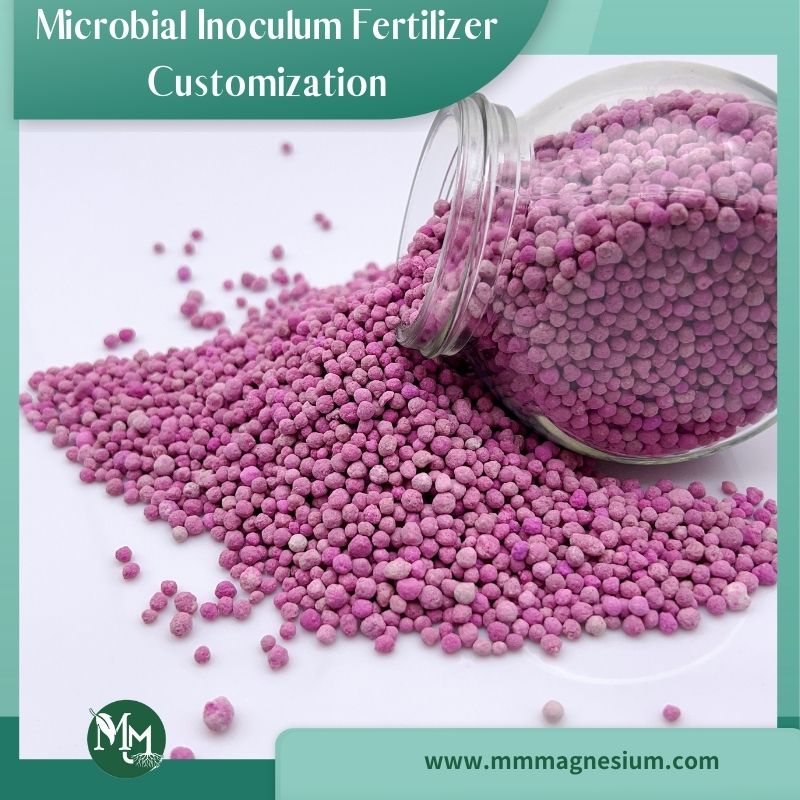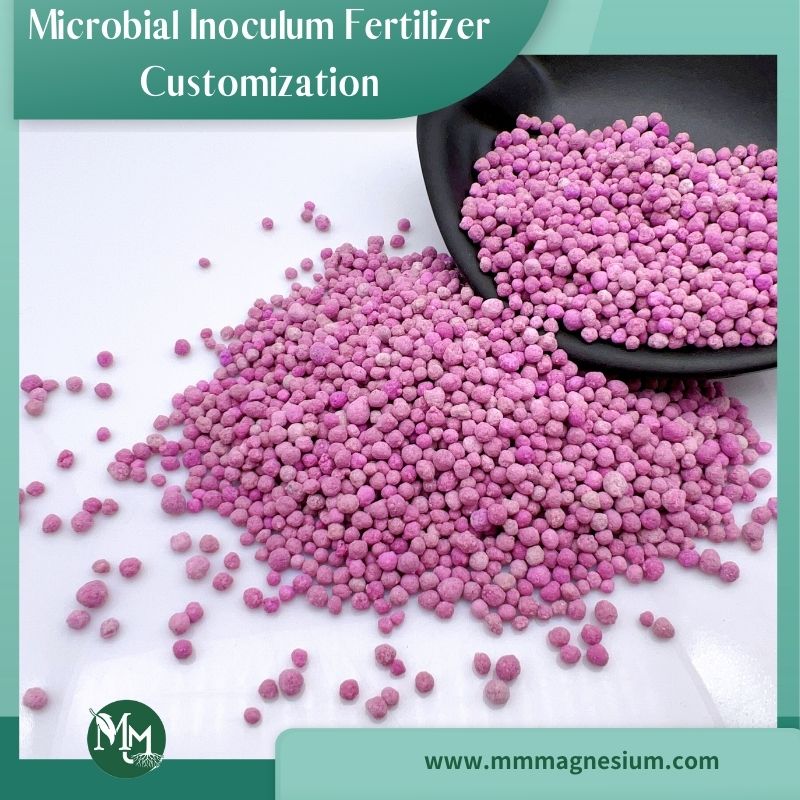

Effective live bacteria count ≥ 500 million/g
Effective live bacteria name: Bacillus subtilis, Bacillus licheniformis, Bacillus amyloliquefaciens, Rhizobium, etc.
Si+Ca+Mg ≥ 25%
Trace elements ≥ 2%
Granular size: 2-4mm
Applicable crops: This product is suitable for field crops such as rice, corn, and wheat; fruit and vegetable crops such as apples, peaches, and tomatoes; and economic crops such as onions, garlic, peanuts, and potatoes.




Yingkou Maomei Agricultural Technology Co., Ltd., relying on high-quality mineral resources, produces microbial inoculum fertilizer products with advanced technology and the following characteristics:
Products are exported to the United States, Russia, Indonesia, Canada, Spain, Malaysia, Bangladesh, and other countries, and also cover all provinces, cities, and regions across the country.
For more service advantages of Yingkou Maomei Agricultural Technology, please see Why choose us? and Factory Photos.
Advantages of Microbial Agents Fertilizer, Customization
1. Provide comprehensive nutrition: This fertilizer contains a variety of essential trace elements such as silicon, calcium, magnesium, sulfur, boron, zinc, and iron, which can meet the various nutrients required for crop growth and prevent and correct growth disorders caused by the lack of certain elements.
2. Enhance crop disease resistance: Microbial agents can inhibit the growth of harmful pathogens in the soil and reduce the occurrence of soil-borne diseases. At the same time, these agents can also promote the crop's own immune system and improve the disease resistance of crops.
3. Improve soil structure: Elements such as silicon and calcium in fertilizers help improve the physical structure of the soil, enhance the soil's aeration and water retention. Microbial agents decompose organic matter, promote the formation of soil aggregate structure, and improve soil fertility.
4. Improve nutrient utilization: Microbial agents can improve the effectiveness of nutrients in the soil and the absorption efficiency of plants by fixing nitrogen, dissolving phosphorus, and dissolving potassium, reduce the use of chemical fertilizers, and improve fertilizer utilization.
5. Promote root growth: The microbial agents in the fertilizer can secrete plant growth hormones, promote the development and growth of the root system, enhance the water and fertilizer absorption capacity of crops, and improve the stress resistance of crops.
6. Improve crop yield and quality: Under the combined effect, this fertilizer can significantly improve the yield and quality of crops. The reasonable supply of trace elements and the multiple effects of microbial agents make crops grow stronger, the fruits are fuller, and the quality is higher.

Fertilization Recommendations
The following dosage recommendations can be adjusted according to soil fertility, crop needs and fertilization schemes.

1. Protect from rain and sunlight, store in a ventilated and dry place, and do not transport or store together with toxic and hazardous substances.
2. Each bag is 25 kg, and we can also provide packaging as small as 1 kg or as large as ton bags according to customer requirements.
3. Plastic woven bags, lined with plastic inner bags. We provide all available packaging such as paper plastic bags/kraft paper bags/PE bags.
4. We provide a variety of transportation methods: road transportation, railway transportation, air transportation, container transportation, and ocean transportation.
5. Our company's marks can provide OEM or neutral marks.

FAQ
1.What is the color of the fertilizer?
The appearance and color of our fertilizers vary depending on the product type and formulation. Usually, our fertilizers are in powder or granular form and may be white, gray, brown or black. These colors are caused by the different ingredients and additives contained in the fertilizers and do not affect the quality and effect of the product. The product color can also be customized according to customer needs.
2.Do your fertilizers contain trace elements?
Yes, our fertilizers are rich in trace elements. These trace elements are necessary for plant growth and development, including iron, zinc, copper, manganese, boron, etc. We precisely control the content and proportion of trace elements to ensure that plants can fully absorb these nutrients and maintain healthy growth.

Product Knowledge:Effects of medium and trace element fertilizers on reducing heavy metal absorption in crops

Heavy metal pollution not only affects crop growth, but also poses a potential threat to human health. Medium and trace element fertilizers have shown significant effects in reducing the absorption of heavy metals by crops. Medium and trace element fertilizers mainly include zinc (Zn), manganese (Mn), iron (Fe), copper (Cu), molybdenum (Mo), boron (B), etc. Although these elements are less abundant in plants, they play important roles in plant growth, development and metabolism. Its mechanism of action in reducing heavy metal absorption by crops mainly includes the following aspects:
1. Competition absorption mechanism: Medium and trace elements have similar chemical properties to heavy metals in soil and can compete with heavy metals for absorption sites, thereby reducing the absorption of heavy metals. For example, zinc and cadmium (Cd) have similar chemical properties, and appropriate application of zinc fertilizer can reduce plant absorption of cadmium.
2. Passivate heavy metals: Medium and trace element fertilizers can change the chemical form of heavy metals in the soil, converting them into forms that are difficult for plants to absorb. For example, iron fertilizer can convert soluble lead (Pb) in the soil into insoluble lead compounds, thereby reducing the absorption of lead by plants.
3. Enhance plant resistance: Medium and trace elements can promote the growth and development of plants and enhance their stress resistance and repair capabilities. For example, manganese and copper can improve the antioxidant capacity of plants and reduce the damage of heavy metals to plant cells.
Practical application cases
1. Zinc fertilizer reduces cadmium absorption in rice: In a study, scientists planted rice in cadmium-contaminated soil and applied different doses of zinc fertilizer. The results showed that the application of zinc fertilizer significantly reduced the absorption of cadmium by rice, and the cadmium content was reduced by more than 30%. This result shows that zinc fertilizer effectively reduces the absorption of cadmium in rice through a competitive absorption mechanism.
2. Iron fertilizer reduces lead absorption in spinach: In another study, scientists grew spinach in lead-contaminated soil and applied iron fertilizer. Experimental results showed that after the application of iron fertilizer, the lead content in spinach was significantly reduced by 40%. This is because iron fertilizers passivate the lead in the soil, converting it into a form that is difficult for plants to absorb.
3. Manganese fertilizer improves wheat resistance: In a wheat planting experiment, the application of manganese fertilizer significantly improved the wheat's resistance to heavy metal pollution. Wheat treated with manganese fertilizer not only grows healthier, but also absorbs significantly less heavy metals, and the chromium (Cr) and nickel (Ni) content in the soil is reduced by more than 20%.
Medium and trace element fertilizers have broad application prospects in reducing the absorption of heavy metals by crops. It is recommended to pay attention to the following aspects during the application process:
1. Optimize fertilization plan: According to different crops and soil types, optimize the application amount and application method of medium and trace element fertilizers to achieve the best results.
2. Joint application: Study the effect of joint application of trace element fertilizers and other soil amendments (such as organic fertilizers, lime, etc.) to improve soil remediation efficiency.
3. Long-term monitoring and evaluation: Establish a long-term monitoring and evaluation system to evaluate the long-term effect of medium and trace element fertilizers on the remediation of heavy metal pollution in soil and its impact on the environment.
Yingkou Maomei Agricultural Technology Co., Ltd
Name: Brenda
Mobile:86-188-7490-2028
Tel:86-400-699-8826
Whatsapp:86-18874902028
Email:info@maomeimg.com
Add:Qianjia Village, Nanlou Economic Development Zone, Yingkou City, Liaoning Province, China